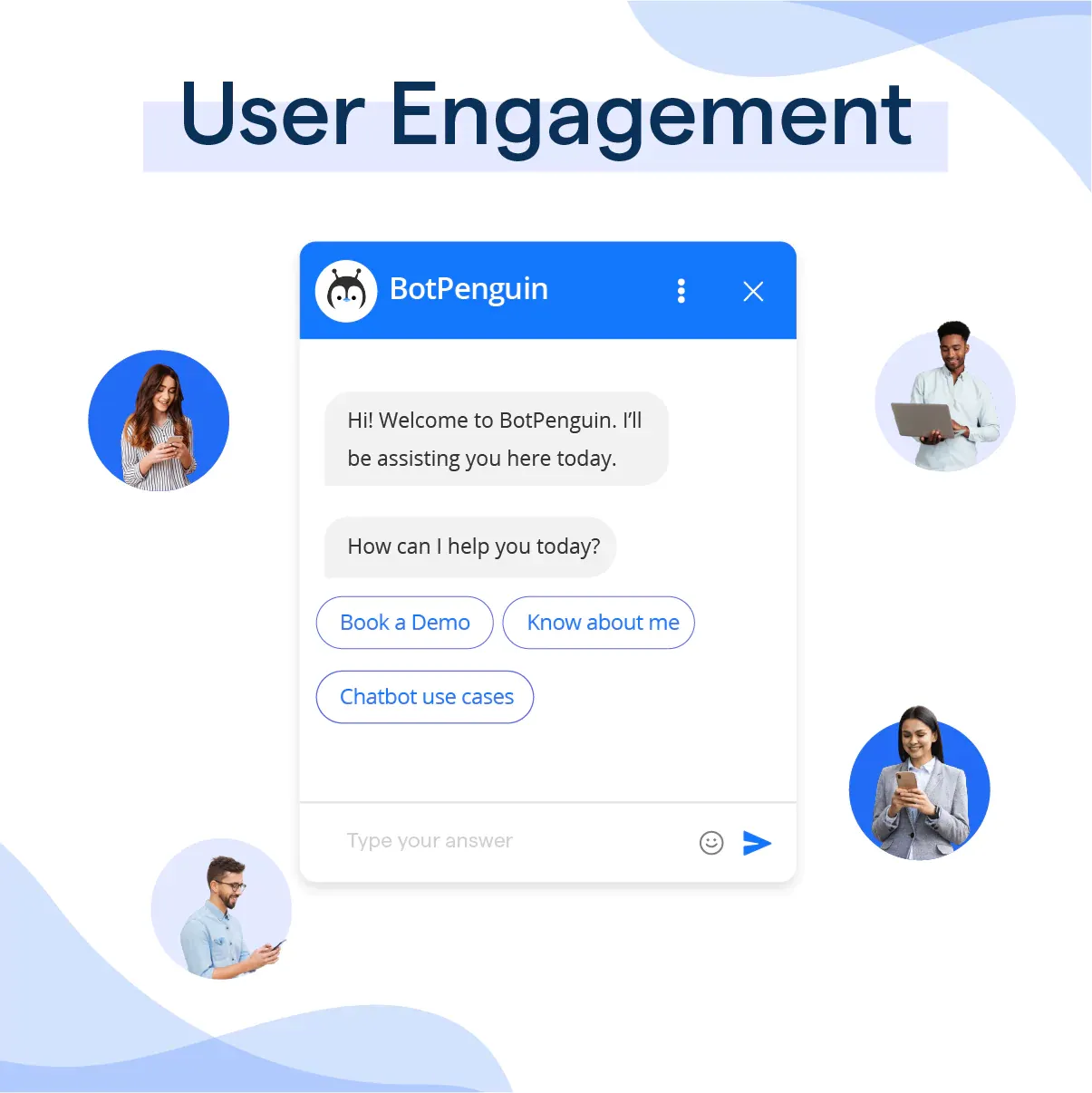User Engagement: An Overview
User engagement is like the excitement and fun you have when playing with your favorite toy, video game, or watching a show you love. It's about how much you enjoy it, how much you want to share it with your friends, and how often you choose to play with it or watch it.
For a website or an app, user engagement means that people really like using it, they spend a lot of time on it, and they keep coming back to it because they find it interesting, helpful, or entertaining. It's important because it tells the people who created the website or app that they are doing a good job and making something that people love.

Understanding user engagement begins with knowing what signs to look for. It involves a range of metrics that offer you insights into user behaviors and preferences. Time spent on your platform, website or app, is one of the primary gauges.
Detailed page views or session lengths can indicate the amount of interest and depth of interaction with your content. Bounce rate and click-through rates speak to the stickiness of your platform—whether users are finding what they’re looking for and quickly moving through your content.
Duration of sessions, comments, shares, likes, and retweets are some signs of active engagement. On the other hand, purchase-related metrics, such as conversion rates, cart abandonment rates, and renewal rates, offer insights into the transactional side of user engagement.
Who: The People Behind the Engagement
User engagement cannot exist without the users themselves. Engaged users wear many hats—they are visitors consuming the content, customers purchasing your services, followers sharing your updates, promoters spreading goodwill about your brand, and even critics providing valuable feedback.
Engaged users are those who interact with your brand consistently and meaningfully, leaving traces that you can follow and learn from. Identifying this cohort enables you to tailor experiences that resonate with them and boost overall engagement.
When: The Timing of Engagement
User engagement is not an isolated event—it’s a journey. It begins from the user's first encounter with your brand and evolves over time. It could be their first visit to your website, first purchase of your product, or even the first follow on your social media profile.
Their journey may grow into regular visits, repeated purchases, and constant interaction with your brand, potentially culminating in loyalty and advocacy. Understanding the timing of these stages helps you adapt your interaction to each user's specific journey stage.
Where: Finding Engagement Across Channels
Engagement can happen anywhere users connect with your brand. This could be on search engine results, emails, newsletters, social media platforms, brand-apps, or online communities.
Uncovering where your most active users are engaging helps you understand their preferred channels and allows you to optimize those platforms accordingly. Then, you can create content specifically for those channels, increasing the chances of improving engagement.
Why: The Significance of User Engagement
The importance of user engagement cannot be underestimated. Engaged users build a deeper bond with your brand—they're the ones who interact more frequently, stay loyal to your brand, and contribute to your business growth.
By improving user engagement, you are not just bolstering numbers; you’re fostering relationships that can result in increased visitor retention, conversions, and ultimately, revenue.
Through the comprehensive understanding of the 5W's of user engagement, you get closer to creating an enviable user engagement strategy—one that results in a vibrant and engaged user community.
The Impact of User Engagement on Profitability
In this section, our focus will be on the critical correlation between user engagement and profitability, shedding light on how the former drives the latter to new heights.
The Power of User Engagement
User engagement is the lifeblood of a successful online presence. It reflects how users interact with your product or service, directly influencing customer loyalty, brand perception, and ultimately profitability.
Translating Engagement into Sales
Higher engagement rates often lead to increased sales. Engaged users are likely to spend more, repurchase, and even become brand ambassadors. Their behaviors can drive higher revenue, contributing to overall profitability.
User Engagement and Customer Retention

Engaged users show a higher tendency for loyalty and retention. Retaining existing customers is cost-effective and results in higher lifetime value, positively impacting profitability.
Lowering Acquisition Costs
By fostering user engagement, businesses can reduce customer acquisition costs. Engaged users often promote the brand organically, leading to free word-of-mouth advertising and bringing in new users at lower costs.
Upselling and Cross-selling Opportunities
Engaged users are more open to upselling and cross-selling, allowing businesses to increase their average transaction value. This can significantly boost profitability.
Driving Proactive Improvements
User engagement analytics provide valuable insights into user preferences and behaviours. Businesses can use these insights to improve product offerings, enhance customer service, and drive operational efficiency, all of which bolster profitability.
In essence, building and nurturing user engagement should be a priority for businesses looking to enhance their profitability. Whether it's through superior product offerings, excellent customer service or personalized experiences, fostering engagement is always a winning strategy.
Stages of User Engagement
From initial awareness to brand advocacy, let's uncover each phase of the journey.
Creating Awareness
Users first become aware of your platform. This stage revolves around making a fantastic first impression. Your site's aesthetics, intuitive design, and easy-to-understand content can captivate users' attention from the first interaction.
Piquing Interest
Once users have noticed you, it's time to pique their interest. Deliver engaging, valuable, and relevant content and features. The goal here is to encourage users to stick around and explore more of what you have to offer.
Driving Consideration
Now you've got their interest, it's time to nurture it. Users begin to weigh the benefits of further engagement. Showcase unique features, testimonials, or free trials to give them a nudge in the right direction—towards deeper engagement with you.
Ensuring Conversion

This is where users take the plunge! Conversion might mean users sign up for a newsletter, make a purchase, or download a resource. This is a critical stage where sustained engagement translates into tangible action.
Maintaining Retention
Now that users have taken action, focus on turning them into repeat customers. Create post-conversion engagement strategies such as follow-up emails, reminders about unused features, or personalized content to keep them loyal to your platform.
Building Advocacy
In this final stage, deeply engaged customers become brand advocates. By providing exceptional experiences, you inspire users to share their positive experiences with others, extending the engagement process to a loop of acquiring new users.
User Engagement by Business Type
Different types of businesses have unique considerations when it comes to User Engagement:
- eCommerce businesses: User Engagement in eCommerce is driven by factors such as product discovery, seamless checkout experiences, personalized recommendations, and post-purchase interactions.
- User Engagement rate calculation: User Engagement rate is a metric that measures the level of user involvement. It can be calculated by dividing the total number of engaged users by the total number of active users within a set time frame.
Strategies to Increase User Engagement
This section pulls back the curtain on various strategies that can take user engagement on your platform to new heights. Let's dive into it!
Revamping Website Design and User Experience
It all starts with aesthetics and smooth navigation. Transform your website's design to be visually appealing and easy to use. Clear navigation, responsive design, and intuitive interfaces can significantly elevate the user experience, keeping users interested and engaged.
Leveraging Interactive Content
How about turning your online visitors from passive onlookers to active participants? Interactive content, like quizzes, polls, or virtual tours, can do just that! It not only spikes users' curiosity but also encourages their active participation, leaving a lasting impression.
Engaging through Social Media

Social media channels can act as ideal platforms to establish a two-way communication with your users. Regular posting, quick response to comments, and sharing user-generated content on these platforms can foster interaction and create a sense of community.
Making Experience Personal
Let's make it 'personal'! The personalized experience caters to the specific needs of users, making them feel valued. From recommended products to personalized emails, highlight how well you know your users, and they will engage more frequently with your platform.
Inviting User-Generated Content
What better way to engage users than having them contribute to your platform? Invite user-generated content, like reviews, pictures, or feedback. It not only adds a personal touch, but also makes users feel like they're part of your brand story.
Monitoring and Optimizing Engagement Metrics

Data tells a tale, but only to those who listen. Keep tracking key engagement metrics like bounce rate, time on site, and user retention. Analyzing this data will provide valuable insights to refine your strategies and precisely cater to your user's needs.
Benefits of Gamification in User Engagement
In this section, we'll explore the various benefits that come from making your users' experience more fun and engaging.
Injecting Fun into Experiences
Gamification breathes life into ordinary tasks, making them more entertaining. By incorporating game-like elements into your platform, you can transform mundane activities into engaging experiences, boosting user interest and satisfaction.
Enhancing Motivation
Game mechanics like leaderboards, points, and badges tap into users' intrinsic motivation, encouraging healthy competition and a sense of achievement. As a result, users feel driven to return to your platform and stay engaged longer.
Boosting Learning and Retention
Gamification can make complex concepts easier to digest. By presenting information through interactive games and quizzes, users can learn at their own pace, enhancing their understanding and knowledge retention.
Strengthening User Loyalty
When users feel motivated and entertained, they develop a positive association with your platform. This deepens their emotional connection with your brand, ultimately leading to a stronger sense of loyalty and long-term commitment.
Encouraging Social Interaction
Features like friend invites, social leaderboards, and community challenges foster socialization among users. This encourages them to share their experiences and achievements with friends, amplifying your platform's reach and attracting new users.
Tracking and Analyzing User Behavior
Gamification provides valuable data on user interactions. By monitoring how users interact with game elements, you can gain insights into their preferences, habits, and motivations. This data can be used to improve and tailor the user experience, boosting engagement even further.
Frequently Asked Questions (FAQs)
What are the benefits of focusing on user engagement?
Focusing on user engagement leads to increased customer satisfaction, loyalty, and profitability. Engaged users become brand advocates, provide valuable feedback, and contribute to business growth.
How can businesses measure user engagement?
User engagement can be measured using metrics such as the number of active users, time spent on the product, repeat visits, and conversion rates. These metrics provide insights into user behavior and satisfaction levels.
What strategies can businesses use to improve user engagement?
Businesses can improve user engagement through strategies like understanding user needs, improving product usability, providing self-paced learning materials, streamlining customer actions, and incorporating gamification elements.
How does user engagement impact profitability?
User engagement directly impacts profitability by driving revenue growth through increased conversions, repeat purchases, and customer advocacy. Engaged users are more likely to become paying customers and contribute to business success.
What role does user engagement play in customer retention?
User engagement plays a crucial role in customer retention. When users are engaged, they are more likely to continue using a product or service, leading to higher customer retention rates and long-term business sustainability.

